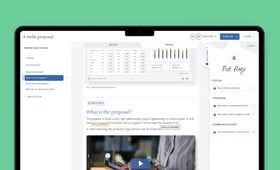This blog is part of a series exploring the findings of our latest Board Report on stakeholder governance. The entire series, including the research, is available at the end of this post.
In this blog, we provide guidelines on how to identify the most telling stakeholder metrics and present them to your board in a way that drives insight.
Start with the questions you want to answer
If you start by sifting through the data you’re already collecting to pull out a metric to track, you’re sure to get tangled in the weeds. Instead, begin with the questions you would like to answer.
What did you always want to understand about your stakeholders? What interesting questions were raised in conversations but couldn’t be answered? Perhaps your board is keen to know:
- Is our culture healthy?
- Why do our customers love our product?
- What is our environmental footprint?
- Do our suppliers like doing business with us?
- How are we supporting our community?
Make a list of those questions and then use data to help you answer them. Don’t skip the important questions that can be hard to measure. Just because you don’t currently measure something, or there isn’t an easy way to do it, doesn’t mean the question isn’t worth answering.
Link stakeholder reporting to your strategy
For most organizations, the biggest challenge of stakeholder reporting is the standalone nature of many metrics. A raft of 10 metrics across key and secondary stakeholders is interesting, but unless performance for the stakeholders is linked to your strategy or purpose, those numbers will never be anything other than “nice”.
“Ask yourself, ‘What is the opportunity to engage stakeholders to help us prosper?’ Companies that are doing well have the strongest narrative about their strategy.”
~ Founding Partner, Board Evaluation Firm
To ensure that all your stakeholders are reflected in your strategic planning, start by understanding their impact on your long-term and short-term success and your own impact on their wellbeing. Beginning with this reciprocal relationship in mind, consider where stakeholder interest and commercial impact meet for each stakeholder. Then, attach specific measures for value creation. Read more on how to link stakeholders to your strategy in our blog on how to embed stakeholders in your board’s decision-making.
Build a balanced organization dashboard
The organization dashboard is a data-illustrated at-a-glance view of the organization’s health. Stakeholder performance is vital to the prosperity of your organization, so stakeholder metrics belong alongside metrics about your strategy, financial performance, and operational and governance information.
If you think of your board reporting as having a pyramid structure, then your organization dashboard is the top of the pyramid, containing the high-level message of the story you’re telling within a single page. Adding key stakeholder metrics to your dashboard allows you to see the performance of your stakeholders in the context of the wider organizational health, so you can identify risks and opportunities faster.
Source “outside-in” data
We were surprised to find in our research that 82% of boards don’t track Glassdoor reviews, despite the fact that they offer a direct, unfiltered pulse of employees’ views and morale.
Your customers, future talent, and the wider community are using social media, review sites, and news sites to form their opinions on you. This perception will reflect their willingness to trust you with their money, support, or career.
Universities, for example, might look at externally reported league tables that present a range of metrics, such as:
- Student satisfaction
- The percentage of students who find employment six months after graduation
- The percentage of first-year students continuing to second year.
These are all powerful data points in determining success.
The sooner you start to take externally reported metrics seriously, the better. See if any of the metrics you’re already tracking can be replaced with a metric monitored externally. Find out if you can supplement an internally reported metric with the findings from an externally reported one.
Want early access to new features and research insights? Register for our newsletter to get notified before everyone else.
Be first to tryPut your greatest effort into predictive metrics
Continuing from the point above, it’s important for the board to “grasp the nettle” of predictive metrics. Nearly all boards track revenue pipeline to predict future performance. In a stakeholder-driven market, your stakeholders’ perception of your organization can serve as a predictive indicator.
However, in our recent research, we found that boards underestimate the power of perception. Instead, they focus on metrics directly related to financial performance, such as growth in customer spend and supplier on-time payments.
“Beating last year’s numbers is not the point; a performance measurement system needs to tell you whether the decisions you’re making now are going to help you in the coming months.”
~ Sir Andrew Likierman, London Business School professor
For each stakeholder group, ask yourself, “What could we track that could indicate potential risks and opportunities?” For example, measuring customer sentiment through a simple metric like net promoter score or customer satisfaction can give you an idea of whether you’re heading in the right direction (surprisingly, 40% of boards don't measure this). Similarly, employee engagement and public sentiment scores can be useful in course-correcting your strategy to improve those relationships.
Determine how frequently your board needs to monitor each metric
There is no right answer to how often your board needs to monitor metrics about each one of your stakeholders. The frequency will be determined by the nature of the question you’ve asked, the impact of the stakeholder on your organization, and several external factors.
For example, if you are a retailer, you probably reviewed metrics relating to your suppliers at least weekly during the Covid-19 crisis. For some key stakeholders, such as your customers and employees, there is information you need to have at your fingertips as it happens.
“We have a sentiment tracker (how are you feeling today?) on the intranet that’s monitored hourly and CEO has direct access to see whether sentiment is going up or down throughout the day.”
~ Company Secretary, UK Building Society
Surprisingly, many organizations feel that annual reviews of stakeholder groups are sufficient. However, 50% of boards look at metrics such as employee engagement only once a year, and 29% look at public sentiment only once a year. We believe this is insufficient, as problems in employee or public sentiment could emerge as major risks to the business in the meantime.
Additional Reading
- World Economic Forum — Measuring Stakeholder Capitalism: Towards Common Metrics and Consistent Reporting of Sustainable Value Creation
- Harvard Business Review — What Are Your KPIs Really Measuring?
- Harvard Business Review — Put Your Metrics Where Your Mouth Is
- Board Intelligence — The CEO Board Report in 90 Seconds
- Board Intelligence — Executive Summaries: The Secret to Better Board Meetings



